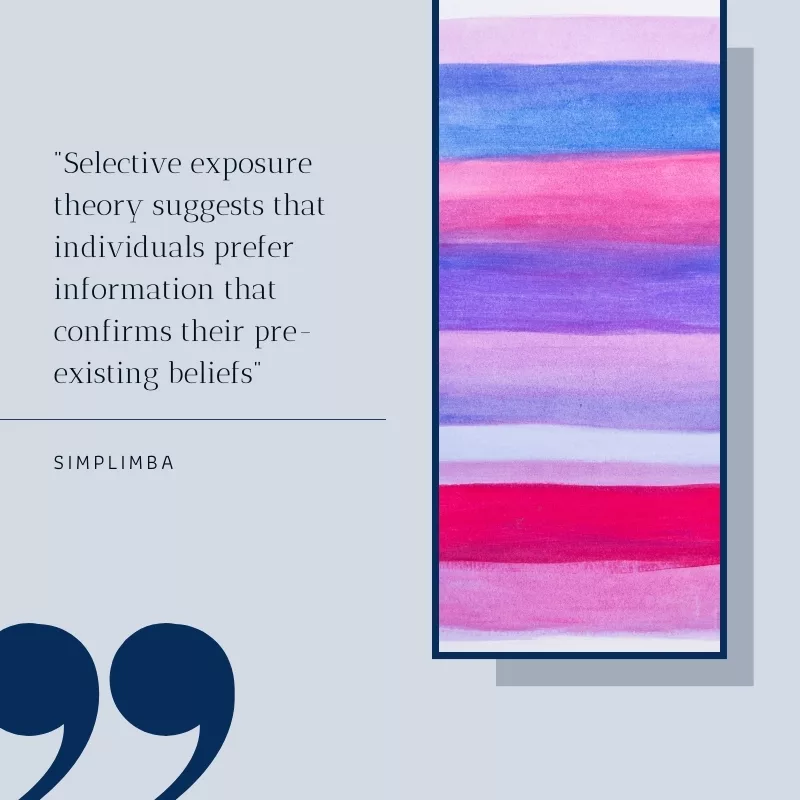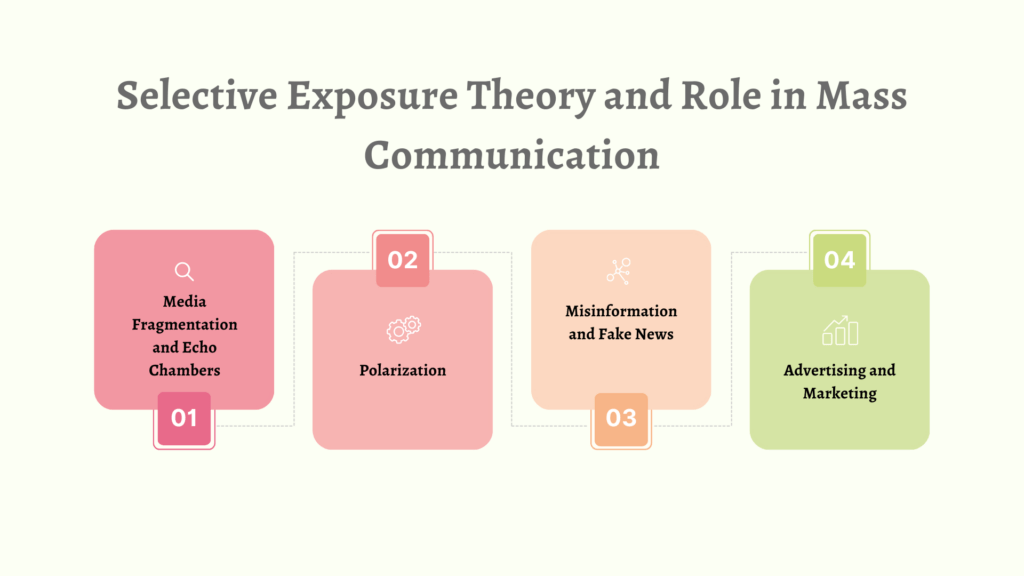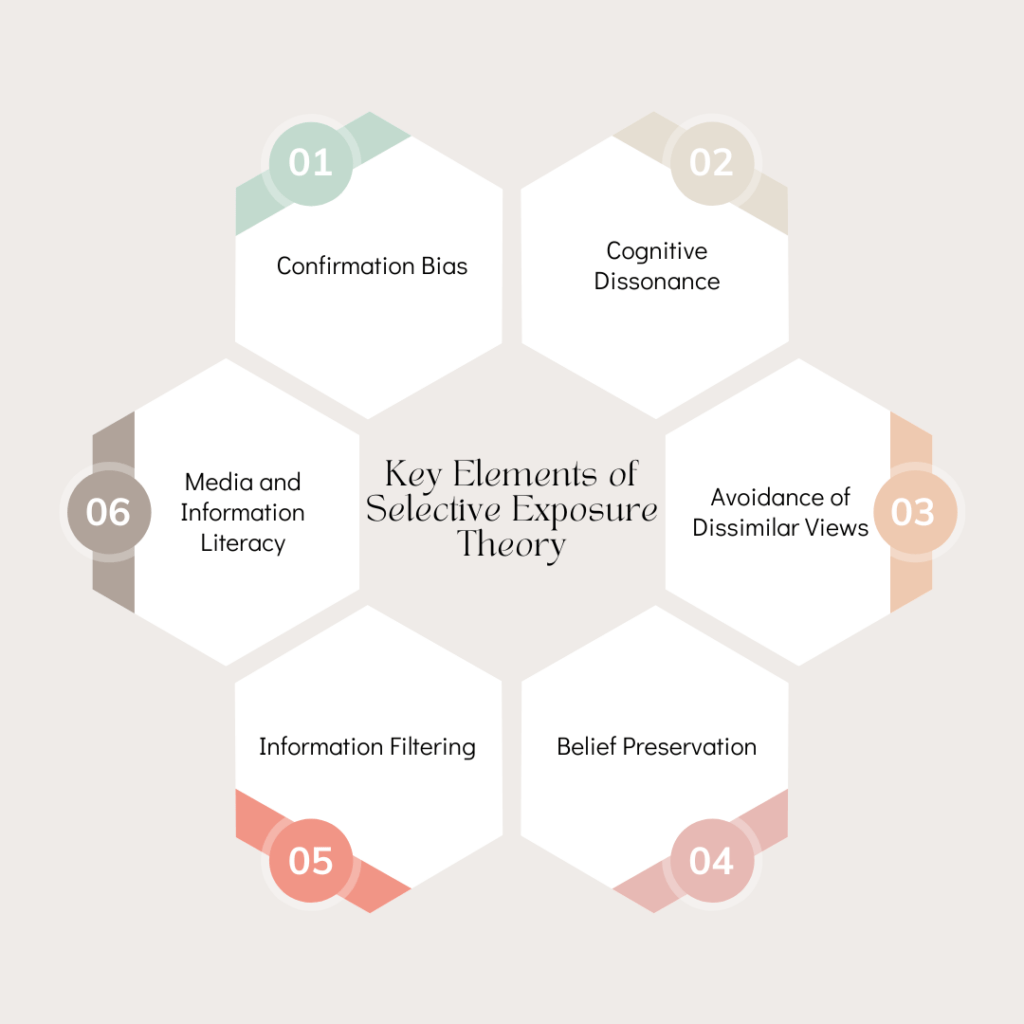Selective Exposure Theory is a concept in psychology and communication that postulates that individuals prefer information that supports their pre-existing values and beliefs while avoiding contradictory information. This theory was first proposed by psychologist Leon Festinger in the 1950s as a part of his Cognitive Dissonance theory. The core idea of Selective Exposure Theory is that people are driven by their desire to reduce cognitive dissonance, which is the discomfort experienced when holding two or more incompatible beliefs or values.
Brief History and Importance

The concept of Selective Exposure Theory has its roots in the work of Festinger and his associates in the mid-20th Century. It was a radical departure from the then-prevailing theories which assumed that people seek out balanced information. Festinger’s work suggested instead that people actively avoid disconfirming information to maintain psychological consistency.
The importance of Selective Exposure Theory cannot be understated. It has implications for myriad areas of study including political communication, health communication, consumer behavior, and education. For example, it can help explain why some individuals resist accepting scientific evidence on topics like climate change or vaccination. Similarly, in the realm of political communication, it can provide insights into the polarized nature of public discourse.
In terms of empirical evidence, a multitude of studies across different disciplines have found support for Selective Exposure Theory. For example, a study published in the Journal of Communication in 2009 found that individuals with strong political beliefs were more likely to select news stories that aligned with their beliefs.
More recently, with the advent of digital technologies and social media, there has been a resurgence of interest in Selective Exposure Theory. The ability to filter information through search engine algorithms and social media feeds has made it easier for individuals to surround themselves with agreeable information while avoiding contrary viewpoints.
It’s important to note though, that while Selective Exposure Theory has considerable empirical support, it’s not without its critics. Some researchers argue that the theory is too deterministic, and doesn’t adequately account for the complexities and variability in how people process information. Despite these critiques, Selective Exposure Theory remains a foundational concept in our understanding of human information behavior.
Want to Learn about 25 Mass Communication Theories that revolutionized the world? Read here
Understanding Selective Exposure Theory
The Science behind Selective Exposure Theory
Selective Exposure Theory (SET) is a concept in psychology and communication that posits that individuals are inclined to favor information that reinforces their pre-existing views while avoiding contradictory information. This bias towards confirmatory information is driven by the desire to reduce cognitive dissonance, a state of mental discomfort arising from conflicting beliefs or values.
Cognitive Dissonance: The foundation of SET is Cognitive Dissonance Theory. Proposed by Leon Festinger in 1957, this theory explains that humans strive for internal consistency. When there is inconsistency (dissonance), it will lead to discomfort, and we engage in certain behaviors to reduce this discomfort. In the case of information consumption, we tend to choose confirming over disconfirming information.
Confirmation Bias: This is another key psychological aspect related to SET. It refers to the tendency to search for, interpret, favor, and recall information in a way that confirms one’s preexisting beliefs or hypotheses while giving disproportionately less consideration to alternative possibilities.
Information Filtering: Advances in technology and the advent of personalized online platforms have made it easier for individuals to filter out disconfirming information. Algorithms can now predict and show content that aligns with one’s beliefs and interests, further reinforcing this theory.
Selective Exposure Theory and Role in Mass Communication
Selective Exposure Theory has significant implications in the field of mass communication, particularly in the era of digital media.

Media Fragmentation and Echo Chambers: The explosion of media outlets has allowed individuals to selectively consume information that confirms their pre-existing beliefs. This leads to the formation of ‘echo chambers’, where one’s beliefs are constantly reinforced and rarely challenged.
Polarization: When individuals are exposed only to perspectives aligned with their own, it leads to further entrenchment of their beliefs, causing societal polarization. Several studies have highlighted the role of SET in the political polarization witnessed in recent times.
Misinformation and Fake News: SET can contribute to the spread of misinformation and fake news, as individuals are more likely to believe and share information that aligns with their pre-existing beliefs and biases, irrespective of its factual accuracy.
Advertising and Marketing: Understanding SET can help marketers and advertisers tailor their messages to specific audiences, increasing the effectiveness of their campaigns.
Want to Learn about 25 Mass Communication Theories that revolutionized the world? Read here
Key Elements of Selective Exposure Theory

Selective Exposure Theory, a significant concept in psychology and communication studies, suggests that individuals tend to prefer information that reinforces their pre-existing views while avoiding contrary information. This theory is increasingly relevant in today’s hyper-partisan and fragmented media environment. Here, we will discuss the key elements of this theory in detail:
Confirmation Bias: The first element of Selective Exposure Theory is confirmation bias. This psychological phenomenon involves the tendency of individuals to seek out, interpret, and remember information that confirms their pre-existing beliefs and biases. This aspect is crucial to the theory, as it fundamentally drives selective exposure behaviors. Research in cognitive psychology suggests that this bias is due to the human tendency for cognitive ease and the avoidance of cognitive dissonance.
Cognitive Dissonance: The second key element is cognitive dissonance, a term coined by Leon Festinger in 1957. Cognitive dissonance refers to the psychological discomfort that arises when one’s beliefs and information at hand are contradictory. Hence, individuals tend to avoid information that might induce such dissonance, thereby selectively exposing themselves to agreeable information.
Avoidance of Dissimilar Views: Selective Exposure Theory also posits that individuals avoid engaging with views and perspectives that differ from their own. This aspect is particularly pronounced in contentious areas such as politics, where individuals can form echo chambers by primarily interacting with information and individuals who share their views.
Belief Preservation: People tend to expose themselves to information that not only confirms their existing beliefs but also actively strengthens and preserves them. This tendency is often linked to the desire for consistency and certainty in an increasingly complex and uncertain world.
Information Filtering In the age of digital media and personalized algorithms, information filtering has become a crucial element of Selective Exposure Theory. Internet users often unknowingly become trapped in “filter bubbles” where the information they receive is heavily curated based on their past preferences and behaviors, reinforcing their pre-existing beliefs.
Media and Information Literacy: Finally, media and information literacy play a crucial role in Selective Exposure Theory. Individuals with higher levels of media literacy are believed to be better equipped to critically evaluate the information they encounter and therefore less prone to selective exposure behaviors.
Want to Learn about 25 Mass Communication Theories that revolutionized the world? Read here
7 Key Insights into Selective Exposure Theory
Selective Exposure Theory posits that individuals are more likely to be exposed to information that aligns with their pre-existing attitudes and beliefs. This process is guided by perception and interpretation based on cognitive schemata, the mental structures we use to organize and interpret information. Perception and interpretation play a major role as they act as filters, emphasizing some elements of the information while ignoring or minimizing others. This selective perception leads to biases that confirm pre-existing beliefs and attitudes, making it more likely for individuals to seek out and retain congruent information.
Cognitive Dissonance and Selective Exposure
The concept of cognitive dissonance, wherein individuals feel discomfort due to holding two or more contradictory beliefs, is an important tenet of Selective Exposure Theory. Individuals tend to avoid information that could create cognitive dissonance, preferring information that confirms their existing beliefs. This avoidance results in selective exposure and further deepens individuals’ belief systems, sometimes leading to a polarized and inflexible mindset.
Impact on Public Opinion and Democracy
Selective Exposure Theory has significant implications for public opinion and democracy. As individuals selectively expose themselves primarily to information that confirms their beliefs, public opinion can become polarized, and the democratic process could be compromised because of a lack of balanced information. This theory underscores the importance of media literacy and critical thinking in democratic societies.
Role in Media Literacy
Media literacy— the ability to critically evaluate and interpret media messages— is crucial to counter the effects of Selective Exposure Theory. Being media literate means being aware of the own biases and actively seeking diverse sources of information, which can help individuals to better understand the complexity of issues and to make more informed decisions.
Influence on Advertising and Marketing
Selective Exposure Theory is widely used in advertising and marketing. Advertisers often target their messages to audiences who are already inclined to receive them positively, thereby increasing the effectiveness of their campaigns. The theory also explains why consumers prefer certain products or brands based on their existing attitudes and values.
Implications for Journalism
Journalism is greatly influenced by Selective Exposure Theory. News outlets often cater to specific audiences with defined beliefs and attitudes, sometimes leading to biased reporting. This can further exacerbate selective exposure, as consumers choose news outlets that align with their views, thereby reinforcing their beliefs and attitudes.
Selective Exposure and Social Media
The advent of social media has amplified the effects of Selective Exposure Theory. Algorithms on social media platforms often favor content that aligns with users’ existing beliefs, creating ‘echo chambers’ and ‘filter bubbles’. This can lead to increased polarization and misinformation, triggering social and political consequences. Therefore, social media users must be aware of these dynamics and strive for a diverse and balanced information diet.
Want to Learn about 25 Mass Communication Theories that revolutionized the world? Read here
The Effects and Consequences of Selective Exposure Theory
Division and Polarization
Selective Exposure Theory posits that individuals prefer messages that align with their pre-existing attitudes and beliefs, and are more prone to avoid or discount messages that challenge these views. This behavior has significant implications for social and political division and polarization.
Ideological Sorting: Selective exposure may lead to ‘ideological sorting’, wherein individuals increasingly surround themselves with like-minded others and information sources. This can further strengthen and consolidate their beliefs, leading to a more polarized society.
Attitude Reinforcement: Consistent exposure to agreeable information may lead to attitude reinforcement, where people’s pre-existing beliefs are continually strengthened. This reinforcement contributes to the strengthening of social and political divides.
Decreased Tolerance for Opposing Views: Selective exposure may decrease individuals’ tolerance for opposing views, as they are continuously exposed to information that validates their beliefs and depicts opposing beliefs negatively.
Echo Chambers and Filter Bubbles
Echo chambers and filter bubbles are two phenomena closely tied to selective exposure theory.
Echo Chambers: Selective exposure may lead to the creation of ‘echo chambers’, wherein individuals are exposed mostly to information that confirms their pre-existing beliefs, creating an environment where the same opinions are echoed back and forth without challenge.
Filter Bubbles: Selective exposure is also at the root of ‘filter bubbles’, a phenomenon where algorithms on digital platforms curate content based on an individual’s previous behavior, further reinforcing their existing beliefs and attitudes.
Impact on Public Discourse: Both echo chambers and filter bubbles can distort public discourse, as they limit the diversity of information and perspectives individuals are exposed to, potentially leading to a misinformed public.
Inequality of Political Knowledge: Echo Chambers and filter bubbles can also contribute to inequality of political knowledge, where some groups are more informed than others, which can have significant consequences for democratic processes.
Media Literacy Education:
Definition and Importance: Media literacy education refers to the process of teaching individuals, especially young people, about how to critically analyze the messages they receive through various forms of media. It involves understanding the ways media messages shape our culture and society, identifying the roles of media in our lives and its influences, recognizing different types of media and their workings, and making informed decisions as consumers and producers of information.
Graduate-level Courses and Seminars: Higher educational institutions can offer media literacy courses that train students to identify bias, fake news, manipulative tactics, and other deceptive strategies used in digital media. These courses should not only focus on the theoretical aspects but also include practical sessions where students analyze real media content.
School Curriculum Integration: Media literacy education should be integrated into the school curriculum from a young age. The objective should be to educate children about different types of media, their purposes, and the ways they can manipulate our perceptions.
Public Workshops and Training Programs: Governments and non-profit organizations can help spread media literacy through public workshops and training programs. These workshops can educate people about the importance of diversifying their media consumption and understanding algorithm transparency.
Diversifying Media Consumption:
The Role of Diverse Media Consumption: Consuming a wide range of media outlets can help to counteract the effects of algorithmic personalization and prevent the formation of echo chambers, where individuals are exposed only to information that reinforces their existing beliefs.
Variety in Platforms: Encourage the use of a variety of platforms (such as print, TV, digital, etc.) for news consumption. This will allow individuals to gain different perspectives and reduce reliance on a particular type of media.
International Media Exposure: International media exposure can provide different perspectives on global issues and foster a more holistic understanding of the world. This can be promoted through policies that ensure access to international media outlets.
Media Consumption Tracking: Educate consumers to regularly track and review their media consumption habits. Encourage them to include independent, lesser-known sources for a balanced view.
Encouraging Transparency in Algorithms:
The Need for Transparency: The lack of transparency in how algorithms work and make decisions is a significant concern. Encouraging transparency can help users understand why they receive certain content and how their online behaviors influence the information they see.
Regulation and Policy Development: Government regulation may be needed to mandate transparency in algorithms, especially those used by major social media and news platforms. Policies should require companies to explain their algorithms in understandable terms to the public.
User Education: Users should be educated about how algorithms work, how they shape the content they see, and how they can be manipulated. This can be part of broader media literacy education.
Auditing Algorithms: Independent audits of algorithms can ensure they are functioning correctly, are free from biases, and are transparent. These audits should be carried out by third-party organizations specialized in algorithmic auditing
Want to Learn about 25 Mass Communication Theories that revolutionized the world? Read here
Samrat is a Delhi-based MBA from the Indian Institute of Management. He is a Strategy, AI, and Marketing Enthusiast and passionately writes about core and emerging topics in Management studies. Reach out to his LinkedIn for a discussion or follow his Quora Page
